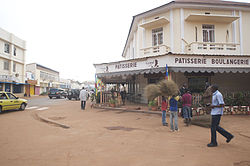| Languages of the Central African Republic | |
|---|---|
 | |
| Official | French (Standard), Sango |
| Indigenous | Ubangian languages, Runga, Bongo–Bagirmi languages, some Bantu languages |
| Vernacular | African French |
| Foreign | English, Russian, Arabic (Chadian Arabic) |
| Signed | American Sign Language (Francophone African Sign Language) |
| Keyboard layout | |
| Part of a series on the |
| Culture of the Central African Republic |
|---|
 |
| People |
| Languages |
| Cuisine |
| Religion |
| Music |
| Sport |

The official languages of the Central African Republic are French and Sango. In total there are about 72 languages in the country.[1]
In the CAR, French is the language of writing and formal situations. In 2022, French is spoken by 28.6% of the population (1.4 million people).[2][3]
Sango has about 350,000 native speakers. It has become the lingua franca of the country. It became a national language in 1963 and an official language (alongside French) in 1991. It is estimated that 92% of the CAR's population is able to speak Sango. The language has become the mother tongue of almost all children in Bangui.[4]
Nearly all of the native languages of the CAR belong to the Ubangian languages. There are a few Bantu languages in the extreme south, along the border with Congo-Brazzaville, and several Bongo–Bagirmi languages in the north, near the border with Chad. In addition, there is a Maban language, Runga. Chadian (Shuwa) Arabic is spoken by at least 127,000 Baggara Arabs (Misseriya) in the northern part of the country around Vakaga Prefecture. Sudanese Arabic and Juba Arabic are spoken by Fertit Arabs and Turku Arabs, respectively, in addition to tens of thousands of refugees from Sudan and South Sudan. Several Arabized Muslim African ethnic groups such as the Runga have adopted Arabic is a primary or secondary language.
Education for the deaf in CAR uses American Sign Language, introduced by the deaf American missionary Andrew Foster.
- ^ "Central African Republic – Country". Ethnologue.
- ^ Richard, Marcoux. "Estimation des populations francophones dans le monde en 2022" (PDF). Organisation internationale de la Francophonie (in French). Retrieved 2023-01-14.
- ^ Beck, Baptiste; Marcoux, Richard; Richard, Laurent; Wolff, Alexandre (2018). Estimation des populations francophones dans le monde en 2018: Sources et démarches méthodologiques [Estimation of French-speaking populations in the world in 2018: Methodological sources and approaches] (PDF) (Report). Note de recherche de l'ODSEF (in French). Québec: Observatoire démographique et statistique de l'espace francophone, Université Laval. p. 45. Retrieved 2020-05-28.
- ^ "Central African Republic – Language". Ethnologue. Retrieved 2020-05-25.
